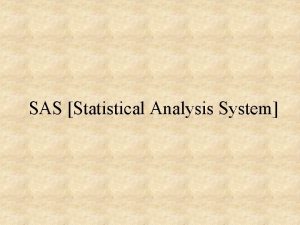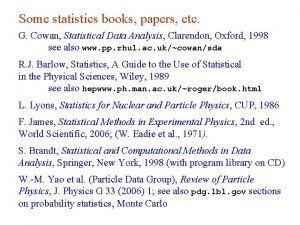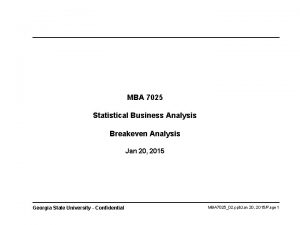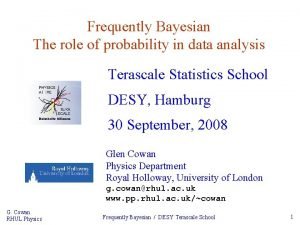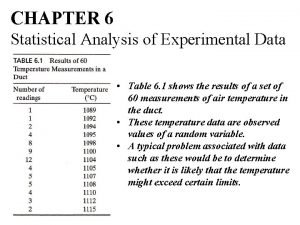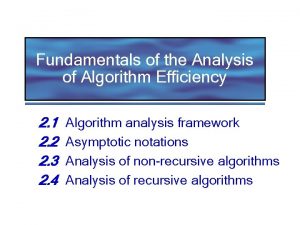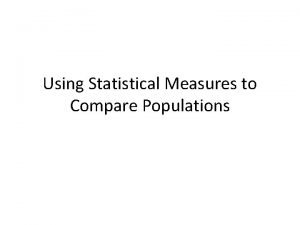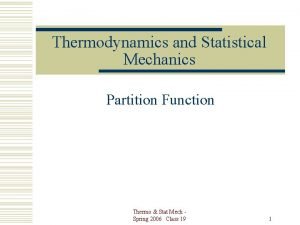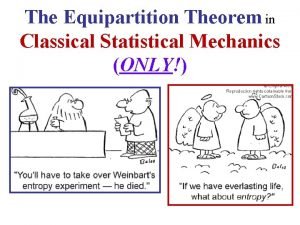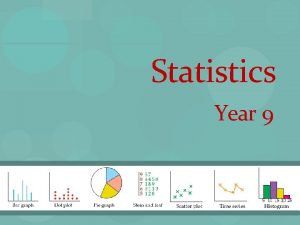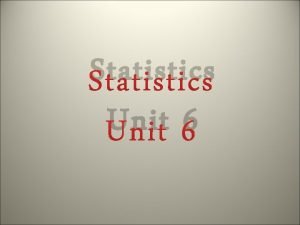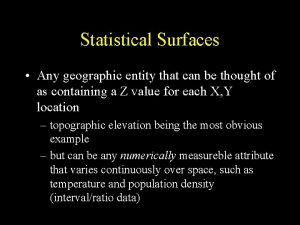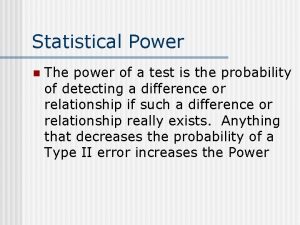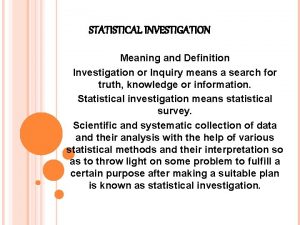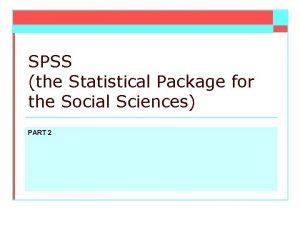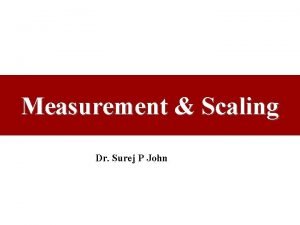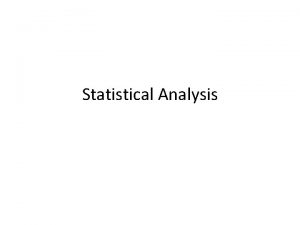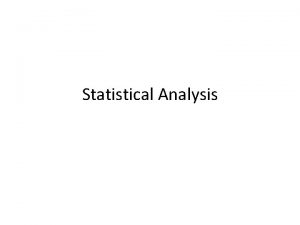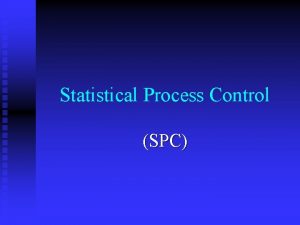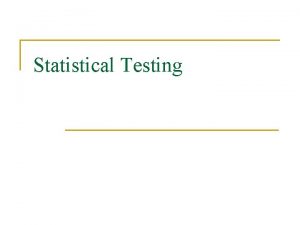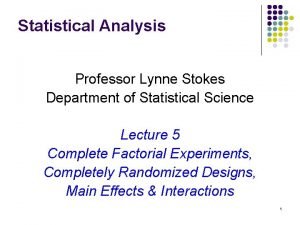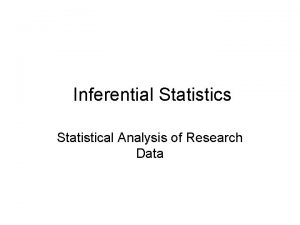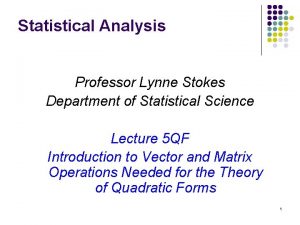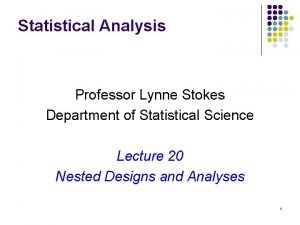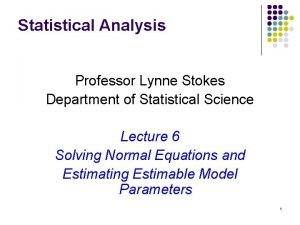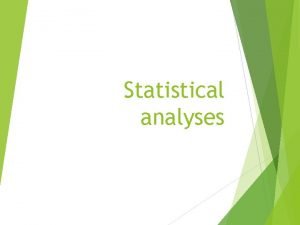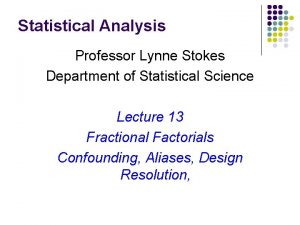Fundamentals of Statistical Analysis DR SUREJ P JOHN



























- Slides: 27

Fundamentals of Statistical Analysis DR. SUREJ P JOHN

Definition of Variables A variable is an attribute of a person or an object that varies. Measurement are rules for assigning numbers to objects to represent quantities of attributes. Back to Table of Content

Definition Datum is one observation about the variable being measured. Data are a collection of observations. A population consists of all subjects about whom the study is being conducted. A sample is a sub-group of population being examined.

What Is Statistics? Statistics is the science of describing or making inferences about the world from a sample of data. Descriptive statistics are numerical estimates that organize and sum up or present the data. Inferential statistics is the process of inferring from a sample to the population.

Five Types of Statistical Analysis 1. Descriptive analysis – data distribution 2. Inferential analysis – hypothesis testing 3. Differences analysis – hypothesis testing 4. Association analysis – correlation 5. Predictive analysis – regression

Descriptive vs. Inferential Statistics A Hypothesis: A statement relating to an observation that may be true but for which a proof (or disproof) has not been found The results of a well-designed experiment or data collection may lead to the proof or disproof of a hypothesis

Inferential Statistics Samples Sub-samples Population

For example, Heights of male vs. female at age of 25. Our observations: male H > female H; it may be linked to genetics, consumption and exercise etc. Is that true for male H> female H? i. e. Null hypothesis: male H ≤ female H Scenario I: Randomly select 1 person from each sex. Male: 170 Female: 175 Then, Female H> Male H ? Scenario II: Randomly select 3 persons from each sex. Male: 171, 163, 168 Female: 160, 172, 173 What is your conclusion then? Which is the better Scenario?

Important messages here: (1) Sample size is very important and will affect your conclusion (2) Measurement results vary among samples (or subjects) – that is “variation” or “uncertainty”. (3) Variation can be due to measurement errors (random or systematic errors) and inherent within samples variation. For example, at age 20, female height varies from 158 to 189 cm. Why? (4) Therefore, in Statistics, we always deal with distributions of data rather than a single point of measurement or event.


Moments of a Normal Distribution Each moment measures a different dimension of the distribution. 1. Mean (1 st moment) 2. Standard deviation (2 nd moment) 3. Skewness (3 rd moment) 4. Kurtosis (4 th moment)

Mean mean 0 0. 5 1. 0 1. 5 2. 0 2. 5 3. 0 3. 5 4. 0 mm Mean (µ) is equal to the sum of n number of observation divided by the number of observations (sample size) Mean = Sum of values/n = Xi/n e. g. length of 8 fish larvae at day 3 after hatching: 0. 6, 0. 7, 1. 2, 1. 5, 1. 7, 2. 0, 2. 2, 2. 5 mm mean length = (0. 6+0. 7+1. 2+1. 5+1. 7+2. 0+2. 2+2. 5)/8 = 1. 55 mm

Standard deviation The standard deviation (SD) (represented by the Greek letter sigma, σ) shows how much variation or dispersion from the average exists. A low standard deviation indicates that the data points tend to be very close to the mean (also called expected value); a high standard deviation indicates that the data points are spread out over a large range of values. The formula is easy: it is the square root of the Variance. The Variance is defined as: the average of the squared differences from the Mean

Standard deviation

Calculate SD?

Skewness In probability theory and statistics, skewness is a measure of the asymmetry of the probability distribution of a real-valued random variable about its mean. The skewness value can be positive or negative, or even undefined.

Kurtosis The coefficient of Kurtosis is a measure for the degree of peakedness /flatness in the variable distribution. Kurtosis <0 Kurtosis = 0 Kurtosis > 0

Frequency Distribution In statistics, a frequency distribution is an arrangement of the values that one or more variables take in a sample. Each entry in the table contains the frequency or count of the occurrences of values within a particular group or interval, and in this way, the table summarizes the distribution of values in the sample. Frequency distribution tables can be used for both categorical and numeric variables.


Cross Tabulation A cross-tabulation (or cross-tab for short) is a display of data that shows how many cases in each category of one variable are divided among the categories of one or more additional variables. In a cross-tab, a cell is a combination of two or more characteristics, one from each variable. If one variable has two categories and the second variable has four categories, for instance, the cross-tab will have 6 cells, each with a number specific to that category


Left-handed Right-handed Total Males 2 3 5 Females 1 4 5 Total 3 7 10

Comparing Means We need to compare the means of groups in Inferential statistics. T-tests and ANOVA (Analysis of Variance) are the methods commonly used for comparing means. Independent T tests are used for testing the difference between the means of two independent groups. For Independent T-tests, there should be only one independent variable but it can have two levels. There should be only one dependant variable. Ex: gender (male and female) How male and female students differ in academic performance?

Anova (Analysis of Variance) Anova is used as the extension of Independent t-tests. This is used when the researcher is interested in whether the means from several ( >2) independent groups differ. For Avova, only one dependant variable should be present. There should be only ONE independent variable present (but it can have many levels unlike in independent t-tests)

Statistical errors in hypothesis testing

Statistical Errors in Hypothesis Testing Consider court judgments where the accused is presumed innocent until proved guilty beyond reasonable doubt (I. e. Ho = innocent)

Statistical Errors in Hypothesis Testing Similar to court judgments, in testing a null hypothesis in statistics, we also suffer from the similar kind of errors:
 Statistical analysis system
Statistical analysis system Ascenex
Ascenex Preserving statistical validity in adaptive data analysis
Preserving statistical validity in adaptive data analysis Multivariate statistical analysis
Multivariate statistical analysis Cowan statistical data analysis
Cowan statistical data analysis Statistical business analysis
Statistical business analysis Marketing analytics software r
Marketing analytics software r State bayes theorem
State bayes theorem Statistical analysis of experimental data
Statistical analysis of experimental data Ali sekmen
Ali sekmen Measuring algorithm efficiency
Measuring algorithm efficiency Gss recruitment
Gss recruitment Using statistical measures to compare populations
Using statistical measures to compare populations Stat
Stat Statistical mechanics
Statistical mechanics Equipartition theorem proof
Equipartition theorem proof Statistical displays
Statistical displays Types of statistical questions
Types of statistical questions What is statistical time division multiplexing
What is statistical time division multiplexing Statistical thermodynamics in chemistry
Statistical thermodynamics in chemistry What is microcanonical ensemble
What is microcanonical ensemble Bmk+
Bmk+ A statistical surface has a
A statistical surface has a Statistical significance p value
Statistical significance p value Statistical power table
Statistical power table Natural language processing fields
Natural language processing fields Meaning:investigation
Meaning:investigation Statistical package for social science
Statistical package for social science
